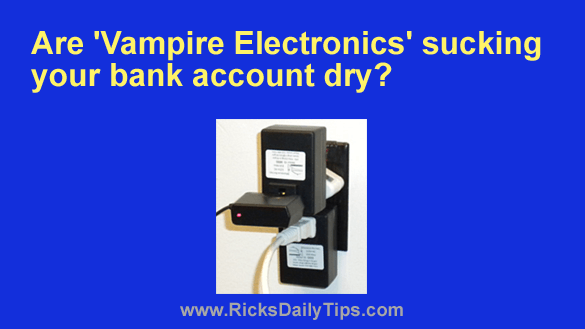 You probably know that turning the light off when you leave a room can help keep electric bills a little lower than they would be otherwise.
You probably know that turning the light off when you leave a room can help keep electric bills a little lower than they would be otherwise.
But did you know the average home contains numerous “electronic vampires” that can suck your bank account dry if you let them?
Just what are these electronic vampires?
In a nutshell, they’re electronic devices that sip electricity from the electrical grid even when you aren’t using them.
One of the most common offenders is the small transformer-type charger/power adapter that plugs in the wall and stays there, sipping current, even when the device it connects to is turned off or not even plugged in to it.
Granted, the amount of electricity consumed by a single transformer is tiny in the grand scheme of things, but if your home has a half-dozen or more of them plugged in 24 hours per day, that’s a lot of kilowatts being wasted each and every year.
Other “vampire” devices include flat screen TVs, cable converter boxes, high speed modems, routers, emergency radio scanners, laptop computers, printers, certain kitchen and bathroom appliances and a wide variety of other specialty electronic devices.
As long as these items remain plugged in to a wall outlet they’ll continue sipping electricity even when they are turned off.
The only effective way to prevent these items from wasting electricity it to unplug them from their electrical outlets when they aren’t being used.
Of course that can be difficult when the outlet is hidden behind a piece of furniture, but a power strip (or even better, a surge protector) makes it easy to “unplug” several devices at once simply by pressing its power switch.
Just bear aware that while a surge protector will definitely make it easier to electrically disconnect your devices from the power grid, unplugging idle electronic devices completely is a lot better. Here’s why…
If a piece of equipment isn’t plugged into an electrical outlet it cannot be damaged or destroyed by a lightning strike or power surge.
After all, surge protectors are far from perfect, especially if your home’s local power grid is hit with a nearby direct lightning strike.
I can tell you from personal experience that a single lightning strike entering your home via the power line can wipe out thousands of dollars worth of appliances and electronic items in a split second.
Bottom line: While there is a certain amount of inconvenience involved with regular unplugging and re-plugging, it’s well worth the effort when you consider the benefits.
If saving money on your electric bill and protecting your expensive gear from power surges and lightning strikes is important to you, this is a great way to do both at the same time.
Bonus tip: This post explains why your surge protectors might be giving you a false sense of security.